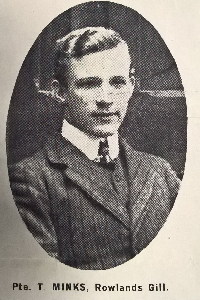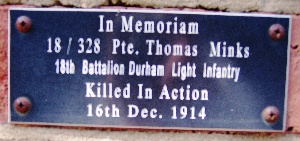
Consett Guardian Almanack 1915

Hartlepool Memorial Garden
Medal Index Card
Newcastle Journal Saturday 19/12/1914
Newcastle Journal Friday 18/12/1914
Thomas Minks was born at 9 Allendale Cottages, between Medomsley and High Westwood, Durham, on the 5th January 1889, the second eldest son of Robert and Elizabeth. He was baptised at Medomsley on the 6th February.
The other children were William Bailey born 1879, Mary Jane born 1890, Alice Hannah born 1892, Martha Amelia born 1894, Mavis born 1897 and Robert Sydney born 1899.
Robert the father was a deputy at Derwent Colliery, Medomsley.
By 1901 the family had moved to 15 Allendale Cottages.
In 1904, Thomas' father Robert committed suicide, decided by an inquest jury a few weeks later when his body was discovered in a remote part of a mine.
Thomas was educated at Westwood Council School, and then at the Consett Pupil Teacher training centre. Whilst training he was a pupil Teacher at Westwood School. He then attended Bede College in Durham to train as a Teacher from September 1907 to July 1909.
In 1911, Elizabeth Minks was a newsagent at Rowlands Gill. Thomas was an Assistant schoolmaster, his sister Alice, was now a student teacher. The rest of the family were assisting their mother in running the news shop.
By 1914, Thomas had become a certified teacher and was employed at the Highfield Council School near Rowlands Gill, working for Durham Education Committee.
His Short Service Attestation form, [3 years service], completed upon his entering the regular army on the 21st September 1914, aged 25, height 5 feet 6 inches, 131 lbs, grey eyes with light brown hair, Church of England, notes that he already had two years of service in the 1/8th Battalion, Durham Light Infantry, Territorial Force. He was then transferred from this unit to the 18th Battalion, the ‘Durham Pals’, Durham Light Infantry. His address at this time was Wellbourne House, Rowlands Gill.
On September 24th, recruits began to assemble rapidly at Cocken Hall, the Durham City and District Contingent marching from the Race-course. They were soon joined by contingents from South Shields, Sunderland, Hartlepool and Darlington. Owing to the rapid increase in numbers additional accommodation had soon to be found, 'B' Company moved to billets in West Rainton and 'A' Company shortly after to Newton Hall. By early October the Battalion was raised to its full establishment, and in the beginning of 1915 it was increased to six companies, about 1300 strong.
During the first six weeks the training had consisted largely of route-marching. Meanwhile two companies of men were despatched to Hartlepool on November 16th 1914 to take up Coast Defence Duty. These two companies were commanded by Major F.T. Tristam and the men were selected who had fired a course on an open range. This detachment entrained at Leamside and proceeded to Hartlepool. On arrival at Hartlepool, they were billeted at Hart Road. Later one company moved to old Hartlepool. The work chiefly composes of providing guards at various tactical points and places of importance, also improvement of the existing trenches.
On December 15th Colonel P. H. Hammond, who was in command of the Tyne and Tees Defences, received information from the War Office of the possibility of a raid by enemy warships on the East Coast on the following day at about 8.30am. The trenches were manned as usual and the rest of the detachment stood to.
Wednesday, 16th December, there was a mist which allowed the German ships to come in close before being detected, also firing out to sea in a clever ruse to give the impression they were British ships retiring.
The previous evening four battle cruisers, ‘Seydlitz’, ‘Moltke’, ‘Von der Tann’ and ‘Derrflinger'; one heavy cruiser, ‘Blucher’, four light cruisers and two flotillas of destroyers had left their base, heading out into the North Sea. The intention was to bombard Hartlepool and Scarborough, both were by now fortified towns and considered legitimate targets.
Facing this massive force armed with a total of twenty 11 inch and twelve 8.2 inch guns were the three six inch guns of the Heugh Battery and a flotilla comprising of two scout cruisers, four destroyers and a [HMS C9] submarine based in the port. That morning the four destroyers HMS Doon, HMS Waveney, HMS Test and HMS Moy a division of the 9th DF, were already at sea but without the scout cruisers HMS Patrol [under the command of Captain Bruce] and HMS Forward which were still in port, [some reports say they were getting ready to sail]. At 8.00am the four destroyers sighted the German ships but their puny 12 pounder armament meant they were hopelessly outgunned and the German warships easily chased them off, but not before HMS Doon fired a torpedo which unfortunately missed.
No-one in the town heard anything. The ‘Seydiltz’, ‘Moltke’ and ‘Blucher’ continued to steam towards the nearest target and the rest headed for Scarborough.
The telephone conversation at this time is recorded.
At 8.00am, War Signal of the Port telephones that the three warships are approaching at great speed. The officer is at once called to the telephone and rings up the Petty Officer.
'What ships are they?' he asks.The Petty Officer answers back-"I believe they are own ships, as they are flying the White Ensign!"
"What class are they?" asks the officer."I believe the Indomitable class," replies the Petty Officer. Immediately after this little colloquy, firing is heard out at sea. The destroyers are assailing and are being assailed."What are they firing at?" asks the officer."I presume at the enemy," says the Petty Officer."Are you sure they are not firing at our own destroyers, which put to sea two hours ago?" is the next question, and "I can't see what they are firing at," is the reply.
At 8.10 a.m. as the inhabitants were readying themselves for the day’s work, the first shell was fired. They were aiming at the shore batteries and the Lighthouse. The shell cut all the lines of communications between the batteries throwing them into confusion.
By 8.25 a.m. most of the ships had come as close as four thousand yards and had begun to pour their fire into the gun emplacements and the docks. Some of the armour piercing shells had delayed action fuses and a number bounced off the batteries into the town.
The first shots landed close to the Heugh Battery, killing Private Theophilus Jones (aged 29) of the 18th Battalion D.L.I. Three other soldiers were fatally wounded at the same time. [Private Leslie David Turner], Theo became known as the first soPrivate ldier to be killed on English soil during the First World War. The first shell landed on the right hand corner of the battery, killing the sentry, and three of the infantry guard. Two more soldiers were killed running to pick up their comrades who had fallen, by the next shell. This also hit the telephone line between the two batteries, so the Commander had to try to relay orders by megaphone. This proved impossible because of the noise, so a man was sent to stand between the command post and the battery to relay orders by word of mouth.
The Lighthouse Battery gun managed to hit the Blucher, killing nine sailors and causing damage to the ship and two of her 6-inch guns. Following this, Blucher placed herself in such a position that the batteries were unable to fire on her because the lighthouse blocked their line of fire.
Three British coastal defence craft -two light cruisers, HMS Patrol, HMS Forward and a HMS C9 submarine, were moored in the Victoria Dock at the time of the attack. The submarine was hit as it came out of the harbour, which then blocked the way for the cruisers behind it. This left them unable to help during the following attack.
Both batteries fought back bravely but were hampered by misfiring guns and dud ammunition. Fortunately the Germans were using standard anti ship ammunition with time delay fuses which bounced off the gun aprons to explode behind the batteries otherwise casualties among the gunners would have been far higher. Lighthouse Battery did particularly well as one shot seems to have temporarily disabled the Blucher almost forcing her to run aground.
The Germans spent nearly an hour relentlessly bombarding Hartlepool pouring 1,150 shells into the town, for the terrified people it must have seemed that the carnage would never stop. At 8.52am the German squadron fired its last shell and as quickly as it had appeared, it withdrew into the mists of the North Sea. They left 102 people dead including nine soldiers, seven sailors, 15 children and 467 wounded. Seven churches, ten public buildings, five hotels and more than 300 houses were damaged. But the Germans did not escape completely unscathed, the Heugh battery had fired 123 rounds mainly at the Blucher smashing her fore-bridge, damaging some of her guns and killing nine.
For their bravery the Gun Captains at the Heugh were awarded the first ever pair of Military Medals and the Lighthouse Gun Sergeant, Sergeant T. Douthwaite won the Distinguished Conduct Medal. Controversially the commander, Lieutenant Colonel L. Robson also won a number of awards but his subordinates who actually fought the action went unrewarded thanks to their German ancestry.
Thomas Minks died of wounds received from the bombardment of Hartlepool on the 17th December 1914. He was the first Durham County Council employee to die in World War 1. He only completed 88 days in service and was awarded the British War Medal. This was not claimed by his mother until 16th January 1923.
Because his military service was so short he did not qualify for a War Gratuity.
De Ruvigney Roll of Honour Vol 3 page 195.
Adam Smith, head teacher at Highfield School made two entries in the School log;
28/9/1914: Mr. Minks left today to join the "service" tomorrow, "Bede College" Corps.
23/12/1914. Mr. T. Minks CA was killed at Hartlepool on Wednesday 16th December."
"CA" stands for "Certificated Assistant".
His brother Robert Sydney Minks, had moved to Springfield, Guildford Road, Woking, by 1919.
Thomas Minks is remembered in the Teachers who fell entry, Teachers who served entry, at Durham in D47.013d on page 334, on D47.017 D47.052, D47.126 and D47.127, at Consett on C101.13 at High Spen on H106.02 and H106.03 at Medomsley on M36.05 at Hartlepool H115.21 and West Hartlepool on W111.77
There is also a memorial plaque in the Hartlepool Gun Battery, 'Memorial Garden' of Remembrance, which has been recently installed, inscribed with his name.
Roll of Honour Register
First Casualty of the War
The CWGC entry for Private Minks

